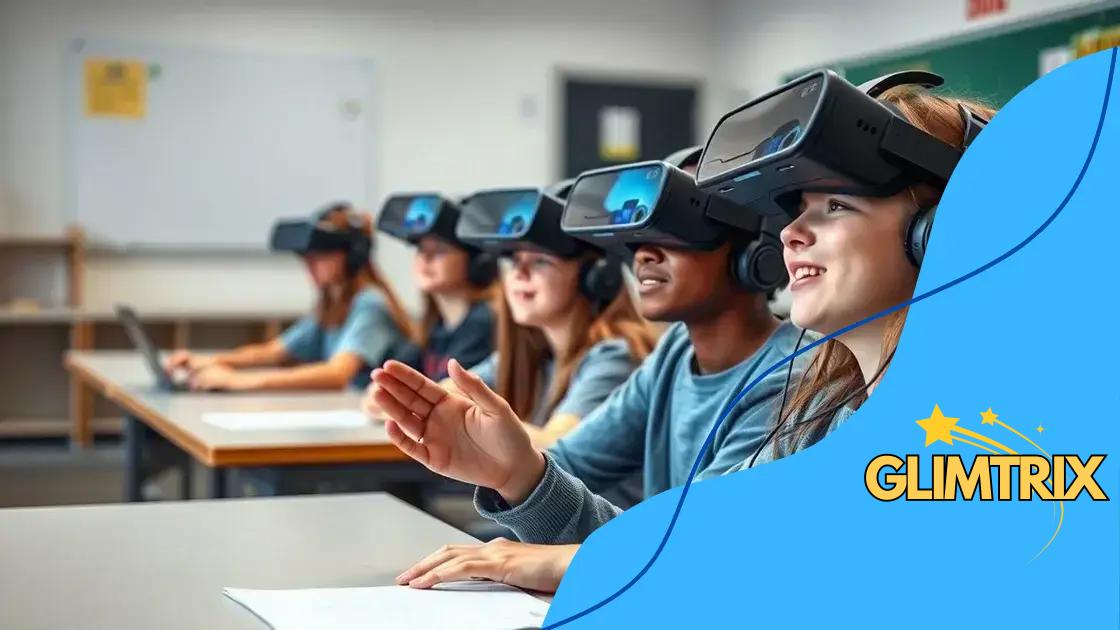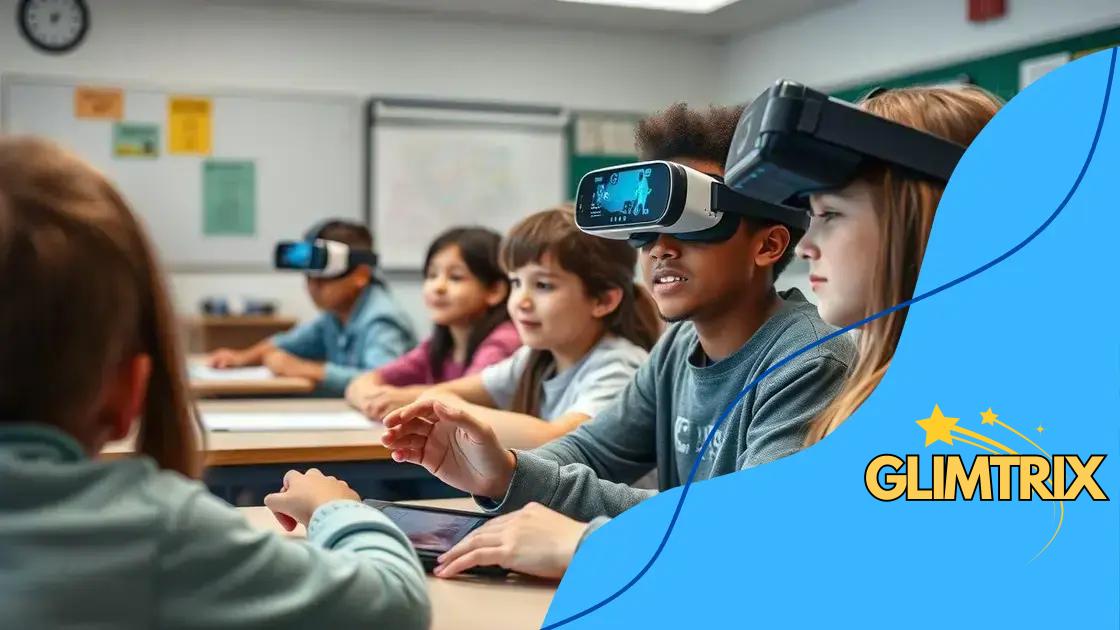How AR is being used for hands-on learning experiences

Augmented reality (AR) enhances hands-on learning experiences by providing interactive and immersive environments that engage students, improve retention, and allow for real-world applications across various fields.
How AR is being used for hands-on learning experiences is transforming education by fostering immersive interactions. Have you ever imagined exploring ancient civilizations through your phone? Let’s dive into how AR enriches our learning journey.
Understanding augmented reality in education
Augmented reality, or AR, is changing education in exciting ways. By blending digital content with the real world, it allows students to experience lessons in a more interactive manner. Imagine learning about the solar system while actually seeing planets rotate around you in the classroom.
The Basics of Augmented Reality
AR enhances our reality by overlaying digital images onto the physical world. It can be accessed through devices like smartphones and tablets. This technology empowers students to engage with content, making learning more memorable.
Key Benefits of AR in Education
- Interactive Learning: Students can interact with 3D models, making complex concepts easier to grasp.
- Enhanced Engagement: AR captures students’ attention, keeping them interested in the subject matter.
- Real-World Applications: Learners can visualize real-life applications of their lessons, boosting understanding.
Moreover, AR is effective for different learning styles. Visual learners benefit from seeing concepts, while kinesthetic learners can engage directly with materials. This versatility helps all students participate fully in their education.
Examples of AR in the Classroom
Many educators are utilizing AR tools to enhance their teaching. For instance, apps like Google Expeditions allow students to take virtual field trips to historical sites. Likewise, Merge Cube lets students hold and manipulate digital objects, providing a hands-on learning experience.
AR also supports collaborative projects. Students work together to solve problems or create presentations. This teamwork fosters communication skills, essential in today’s world.
As AR technology continues to evolve, we can expect even more innovative uses in education. Schools are rarely limited by textbooks when students can interact with their surroundings dynamically.
Benefits of AR for hands-on learning
AR enhances hands-on learning by providing immersive experiences that engage students. This exciting technology allows them to interact with materials in a way that traditional methods cannot. By using AR, learners can grasp complex subjects more easily.
Key Advantages of Using AR
With AR, students can visualize concepts that may be difficult to understand through text alone. For example, a biology student can explore the anatomy of a frog by seeing the organs in a virtual model, instead of just reading about them.
- Increased Engagement: AR captures students’ attention and maintains their interest throughout lessons.
- Enhanced Retention: Interactive experiences help students remember information longer.
- Personalized Learning: AR can be tailored to fit individual learning paces and styles.
Moreover, AR fosters collaboration among students. When working on group projects, they can explore and solve problems together in a dynamic way. This collaboration builds communication skills, which are vital in today’s world.
Real-World Applications of AR in Learning
Many schools are successfully integrating AR into their curricula. For instance, architecture students can use AR tools to visualize building designs in real-time. Similarly, history classes can take virtual field trips to ancient ruins, making lessons more engaging and memorable.
Additionally, AR facilitates skill-based learning. In vocational training, learners can practice tasks in a simulated environment, which enhances their abilities without the risk of real-world consequences. This hands-on practice ensures they are better prepared for future careers.
Overall, the benefits of AR for hands-on learning are profound. By making lessons more accessible and engaging, educators can foster a love of learning that lasts a lifetime.
Effective AR tools for classroom engagement

Several effective AR tools are available to enhance classroom engagement and make learning more interactive. These tools provide unique experiences that captivate students, transforming traditional lessons into exciting adventures.
Popular AR Applications
One popular app is Google Expeditions. It allows teachers to take students on virtual field trips to incredible locations around the world. Whether exploring the Great Barrier Reef or wandering through ancient ruins, students can immerse themselves in different environments right from the classroom.
- AR Flashcards: These interactive flashcards help younger students learn vocabulary and numbers with fun visuals.
- Merge Cube: This tool allows students to hold digital objects in their hands, making subjects like science come alive.
- Quiver: With this app, students can color templates and watch their drawings animate in 3D, blending art with technology.
Another impressive tool is Assemblr. This platform lets both teachers and students create their own AR content. By designing interactive models and animations, learners can express creativity while deepening their understanding of various topics.
Benefits of Using AR Tools
Using these AR tools brings numerous benefits to the classroom. For example, they can increase motivation by making lessons more engaging. Students are more likely to participate and focus on activities when they use technology that excites them.
Moreover, AR supports collaboration among students. Many of these tools include features that allow groups to work together on projects. This teamwork helps strengthen communication skills and fosters a sense of community in the classroom.
Incorporating AR into lessons also accommodates different learning styles. Visual learners thrive with interactive content, while kinesthetic learners benefit from hands-on experiences.
Real-world applications of AR in training
Augmented reality (AR) is making a significant impact in training across various fields. By providing immersive and interactive experiences, AR helps learners grasp complex skills in real-world scenarios.
Industry-Specific Uses of AR
In the healthcare sector, AR is used for training medical students and professionals. For example, surgical simulations allow trainees to practice procedures in a safe environment. They can see 3D models of organs and structures, enhancing their understanding without the risk of affecting real patients.
- Manufacturing and Maintenance: Workers can use AR to visualize machine components and workflows, helping them follow instructions accurately.
- Construction: AR aids in visualizing building projects on-site. Workers can see how structures fit into the environment before they start construction.
- Aviation: Pilots benefit from AR training that simulates flight conditions, allowing them to practice emergency procedures in a controlled, realistic way.
Furthermore, AR is increasingly used in retail training. Sales associates can use AR apps to learn about products and customer service techniques in a hands-on manner. This method not only increases their confidence but also improves customer interactions.
Advantages of AR in Training
The use of AR in training comes with numerous advantages. It promotes active learning, as trainees can engage directly with the material. This interaction helps solidify concepts and improves retention. Additionally, AR training can be done remotely, which is essential for companies with multiple locations.
Moreover, AR provides instant feedback. Trainees can correct mistakes as they practice, leading to faster skill acquisition. This immediate response helps ensure that learners are on the right track and can adapt quickly to new information.
Overall, the real-world applications of AR in training provide transformative benefits. By bridging the gap between theory and practice, AR equips learners with the tools they need for success in their careers.
Challenges and future of AR in education
The integration of augmented reality (AR) in education brings numerous benefits, but it is not without its challenges. As schools and educators look to implement AR technology, they face various obstacles that can hinder its effectiveness.
Current Challenges of Using AR in Education
One major challenge is the cost of AR tools and devices. Schools with limited budgets may struggle to afford the necessary technology, which can lead to unequal access among students. Additionally, training teachers to use AR effectively is vital. Many educators may not feel comfortable with new technologies, requiring professional development to fully leverage AR’s potential.
- Technical Issues: AR applications might not work seamlessly due to hardware limitations or software bugs.
- Curriculum Integration: Aligning AR with existing curricula can be complex, making it difficult for teachers to include AR lessons.
- Student Distractions: While AR can enhance learning, it can also distract students if not used carefully.
Another issue teachers encounter is the varying levels of student engagement with AR tools. While some students may thrive, others may find it overwhelming or confusing. Educators need to ensure that lessons remain inclusive and that all students can benefit from AR experiences.
The Future Potential of AR in Education
Looking ahead, the future of AR in education holds great promise. As technology evolves, AR tools are expected to become more affordable and user-friendly. This wider availability can lead to broader implementation in classrooms.
Moreover, advancements in AR technology may create more immersive and interactive learning experiences. Imagine students participating in virtual history lessons, exploring ancient cultures in their classrooms. These engaging experiences can foster a deeper understanding of subjects.
Additionally, collaborations between educators and AR developers can lead to tailored solutions that fit educational needs better. By addressing current challenges, AR can become a standard tool in educational settings.
FAQ – Frequently Asked Questions about Augmented Reality in Education
What are the main benefits of using AR in education?
AR enhances student engagement, facilitates hands-on learning, and helps visualize complex concepts, making education more interactive.
What challenges do schools face when implementing AR technology?
Schools may struggle with costs, the need for teacher training, and integrating AR into existing curricula.
How can AR improve student collaboration?
AR tools enable students to work together on projects, encouraging teamwork and communication skills in a fun and interactive way.
What does the future hold for AR in education?
The future of AR in education looks promising, with advancements making technology more affordable and accessible, allowing for broader implementation in classrooms.





